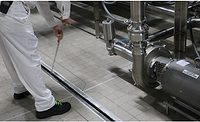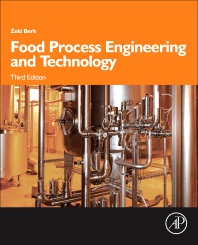Using performance-based indicators, which compare one plant process to another of a similar size and design, is one way to set energy-efficiency targets for manufacturing facilities. But forward-thinking processors are looking at other strategies that take whole-building energy use into account rather than ranking processes one by one.
The sustainable challenge
For the team behind the design and construction of ConAgra Foods’ Lamb Weston Plant in Delhi, LA, the challenge was to create the highest-performing and most efficient sweet potato processing plant possible while providing access to local rail and highway transportation systems, Louisiana’s sweet potato fields and a qualified workforce. With demand increasing, the need for a dedicated plant became clear early in the planning stages in late 2007.
“We had an opportunity to build something from scratch and set out to build a great, sustainable plant because it was right for the business and who we are as a company,” says Rick Martin, vice president for manufacturing at Lamb Weston. “We’ve been producing quality sweet potato products for the past 10 years, which allowed us to bring the best of what we’ve learned to the design and construction of the Delhi plant.”
Health-conscious consumers are eating more sweet potatoes these days, and ConAgra sought to unify its domestic processing in one plant while also taking advantage of newer process technologies to achieve bottom-line efficiency. So, the company instructed its design team to work in an integrated fashion from the start of the project. It was also decided early on that the $156 million, 192,000-sq.-ft. plant would submit paperwork to the US Green Building Council (USGBC) for Leadership in Energy and Environmental Design (LEED) certification. The new plant would also, eventually, bring 275 processing jobs to rural Delhi.
An integrated team
The design and construction team of Fisher & Sons Design/Build, a design and construction firm based in Burlington, WA, and Paladino and Company, a Seattle, WA-based sustainability and green building consulting firm, met early and often with trade subcontractors, process engineers and representatives from ConAgra Lamb Weston to make the right decisions for site selection, building orientation and other key matters.
Paladino’s role was to guide the team in integrating a LEED-certification strategy that would align with and support the sustainability framework and business case model. Autodesk Revit 3D design software was used to design and coordinate the hundreds of miles of mechanical piping, electrical conduits and plumbing before the project broke ground.
Energy goals first
“The design-build process was key because mechanical contractors, the owner, general contractor, process engineering contractors and LEED consultant all sat at same table to discuss issues and work through strategies to achieve our goals,” says Patrick Leonard, project lead for Paladino on the Lamb Weston project. “The process is better than design-bid-build where everyone is siloed away from each other, and there are only handoffs with no outside input. This was about creating the best food processing plant; whatever LEED rating it got was secondary. Lamb Weston does not develop new plants like this every day. This was a once-in-every-10-years kind of thing.”
The design the integrated team created delivered on energy-efficiency goals and LEED points for sustainable sites, water and energy efficiency, recycling construction waste, access for workers who bike to work and other non-plant-specific points.
“Manufacturing is energy, energy, energy, and everything else secondary,” Leonard says. “This was an energy-efficient project in the first place. The difference was that LEED gives a way to point out that companies are doing more than just focusing on energy; it shows they are responsible stewards of the environment and creating a better workplace for their workers, as well as the other things that LEED certifies. If you’re just checking boxes on a scorecard, you’re not going to have this type of energy-efficient, technologically advanced building.”
In fact, the results were astounding. The integrated team delivered a 44 percent reduction in energy use, achieved a 60 percent reduction in water usage through low-flow plumbing fixtures and reduced the plant’s annual natural gas demand by 20 percent by installing an innovative biogas system to treat wastewater through anaerobic digestion and then pumping the steam back in to heat the plant’s boilers. This biogas process also prevents methane, a harmful greenhouse gas, from entering the atmosphere.
The plant runs automated processes during off-peak hours and uses a sophisticated, proprietary building automation system to track and control all energy use. Staff members are devoted to long-term energy forecasting in their procurement departments.
The Lamb Weston Delhi plant opened in 2010, and its energy and water targets have been confirmed by the company’s building commissioning agents. The USGBC gave the plant its highest rating, LEED Platinum, meaning the building creates almost as much energy as it uses and nets zero energy from the electrical grid.
For more information:
Patrick Leonard, Paladino; (206) 957-8565;
patrickl@paladinoandco.com
| Lamb Weston Delhi’s LEED strategy |
|
Below is a list of the individual categories in the USGBC’s LEED-NC (new construction) system and a description of what the Paladino/Fisher team did to achieve points in them at the Lamb Weston Delhi plant. Sustainable sites—Protecting the environment • The landscape is designed to naturally remove pollution from building roof and parking lot storm water runoff, using features such as ponds, swales and wetlands. More than 100 acres of the property are maintained as open space, including protected wetland areas, ponds and restored native vegetation. Water is conserved outside the building by landscaping with native plant species that require no irrigation once established. • Priority parking is given to low-emission, fuel-efficient vehicles. Also, bike racks are available for workers who choose to bike to and from work. • Landscaping and lighter-colored roofing minimize the impact of heat islands that create areas of higher local temperature. Water efficiency • High-efficiency fixtures such as toilets and low-flow shower heads and faucets save about 60 percent of the potable water that would be used by equivalent standard fixtures. • Water is conserved outside the building by landscaping with native plant species that require no irrigation once established. Energy and atmosphere • Energy-saving equipment is projected to save 40 percent of the annual energy consumed at a comparable plant. By identifying and recovering potential wasted energy within the building systems and processes, the plant has greatly reduced energy demand. • Lighting controls dim or turn off lights when not needed throughout the plant. • Biogas, produced by treating process wastewater, is piped back into the plant boilers to produce steam. This process offsets approximately 20 percent of the annual energy demand of the plant and prevents methane, a harmful greenhouse gas, from entering the atmosphere. Materials and resources • Onsite recycling includes sending materials to be reused or reprocessed, rather than taking them to a landfill. Recycled materials include box cardboard, roll cores, totes, polyethylene, metals (cans), light bulbs, batteries, pallets, shredded office paper and cooking oil. • Office cabinets were made from wood sourced from sustainably managed forests certified by the Forest Stewardship Council. • The contractor recycled more than 70 percent of the construction waste generated from building the plant. Wood waste from pallets was ground up and used to prevent soil erosion onsite, preventing more than 300 tons of waste from entering the landfill. Indoor environmental quality • The entire plant is climate controlled to increase worker productivity, safety and comfort. In the office and production areas, employees have adjustable controls to customize the temperature of their workspace. The controls at the process workstations are custom designed. • Indoor air quality is maintained through the use of a high-efficiency air filtration system and low-solvent paints and glues. Innovation in design •The Delhi processing facility was designed with the environment in mind, with the construction process emphasizing water conservation through the use of high-efficiency fixtures and zero irrigation of native landscaping; energy conservation through a commitment to renewable energy systems; minimizing global warming impact through the use of biogas (methane) and refrigerant selection; and construction efficiency through the implementation of materials selection and recycling. • Achieving a LEED rating was a unifying goal during design and construction. An integrated design, with consultants collaborating to optimize sustainability features, was essential to accomplishing LEED Platinum status. Fisher and Sons also educated more than 45 subcontracting firms and 30 vendors on best practices and documentation requirements, providing a legacy of green building in the regional economy. • A comprehensive Green Education Program has been implemented at the plant to educate employees and visitors on what makes the Delhi plant a green manufacturing space and why it is an important act of environmental stewardship. Source http://www.paladinoandco.com/wp-content/uploads/2012/10/LambWeston_DelhiPlant.pdf |








